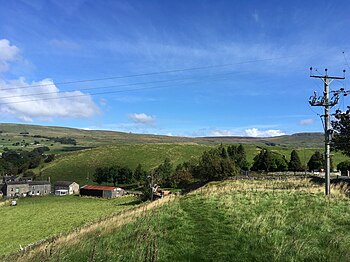Virosidum
| Virosidum | |
|---|---|
 | |
 | |
| Alternative name(s) | Virosidum |
| Known also as | Bainbridge Roman Fort |
| Founded | c. AD 90 |
| Place in the Roman world | |
| Province | Britannia |
| Stationed military units | |
| — Cohorts — | |
| Cohors VI Nerviorum | |
| Location | |
| Coordinates | 54°18′22″N 2°05′49″W / 54.306°N 2.097°WCoordinates: 54°18′22″N 2°05′49″W / 54.306°N 2.097°W |
| Town | Bainbridge |
| County | North Yorkshire |
| Country | England |
| Reference | |
| UK-OSNG reference | SD93769015 |
| Site notes | |
| Condition | Ruined |
Virosidum was a Roman fort and settlement situated near to the modern town of Bainbridge, North Yorkshire, England.[1] The site is a Scheduled monument.[2]
Location[]
The fort occupies a strategically position on the summit of Brough Hill, between the confluence of the River Bain and River Ure. It has views across Wensleydale and may have been placed to control a pass through the Pennines between Stainmore and the Ilkley/Aire gap.[2]

The plateau on which Virosidium was constructed

The Roman road near Virosidium, now a bridle path
History of the fort[]
While the fort may have had an earlier phase, the visible remains date to AD 90–105. It initially had an earth and timber rampart which was rebuilt in study around AD 190.[2]
The visible outline of the defences of the fort contains an areas of 1.16 Hectares (2.8 acres).[3] The fort platform survives to a height of 3.9 m and it is surrounded by a single ditch on the north, east and south sides, with a series of five ditches on the west. An annexe to the fort measures 99 m x 73 m.[1]
The site was abandoned between c.120 and c.160.[3] The fort interior was rebuilt in the early third century by the Cohors VI Nerviorum.[4] Rebuilding across the whole site took place in the late fourth century, with pottery evidence suggesting a late abandonment.[2]
Discovery and excavation[]
In William Camden's 1586 Britannia the fort is referred to under the name Bracchium and this name persisted in early editions of the Ordnance Survey maps. The fort was first excavated by John Kirk and R. G. Collingwood in 1925-6, then by Droop for Liverpool University in 1928-9 and 1931. Under lease to Leeds University, further excavations were directed by William V. Wade in 1950-3 and by Brian Hartley annually from 1956 to 1969.[1]
Finds[]
Five individual inscriptions have been discovered from the fort; three of these were dedicated by the Cohors VI Nerviorum, and a further two are dedicated to individual units.[5] The small finds from the 1956-1969 excavations and a small number of those from the 1920s excavations were deposited with the Yorkshire Museum (ID - YORYM: 2016.201).[6]
Post-Roman Bainbridge[]
There is no clear evidence of continuity into the fifth century at the fort. However, a pair of post-Roman burials were discovered in the principia. One is of an adult aged 36–45 years old and the other of a woman aged 46+ years. Radiocarbon dating of the skeletal remains dated them to the ninth or tenth centuries AD. Isotope analysis of the strontium and oxygen values of their teeth found that the woman was probably local to the Yorkshire region but that the other skeleton was from a western coastal part of Britain or continental Europe. These burials may be consistent with structural changes to the western wall of the principia and the aedes that suggest it was used as a church.[7]
References[]
- ^ Jump up to: a b c Historic England. "Monument No. 7329". Research records (formerly PastScape). Retrieved 1 November 2019.
- ^ Jump up to: a b c d Historic England. "Bainbridge Roman fort and annexe (1017920)". National Heritage List for England. Retrieved 1 November 2019.
- ^ Jump up to: a b Paul Bidwell; Nick Hogson (2009). "Bainbridge, North Yorks.". The Roman Army in Northern England. Arbeia Society. pp. 108–111. ISBN 0905 974 883.
- ^ "RIB 722. Imperial dedication to Septimius Severus, Caracalla, and Geta". Roman Inscriptions of Britain. Retrieved 1 November 2019.
- ^ "Brough-by-Bainbridge". Roman Inscriptions of Britain. Retrieved 1 November 2019.
- ^ Parker, Adam (July 2019). "Information: Bainbridge Roman Fort". Lucerna: The Newsletter of the Roman Finds Group. 57: 22.
- ^ Bidwell, Paul (2012). "The Roman Fort at Bainbridge, Wensleydale: Excavations by B.R. Hartley on the Principia and a Summary Account of Other Excavations and Surveys". Britannia. 43: 45–113.
External links[]
- A.S. Esmonde Cleary, DARMC, R. Talbert, Scott Vanderbilt, R. Warner, Sean Gillies, Jeffrey Becker, and Tom Elliott (2017). "Virosidum: a Pleiades place resource". Pleiades: A Gazetteer of Past Places. Retrieved November 1, 2019.CS1 maint: multiple names: authors list (link)
- Roman fortifications in England
- 90s establishments in the Roman Empire
- 1st-century establishments in Roman Britain
- Scheduled Ancient Monuments in North Yorkshire
- Roman sites in North Yorkshire
- History of North Yorkshire


